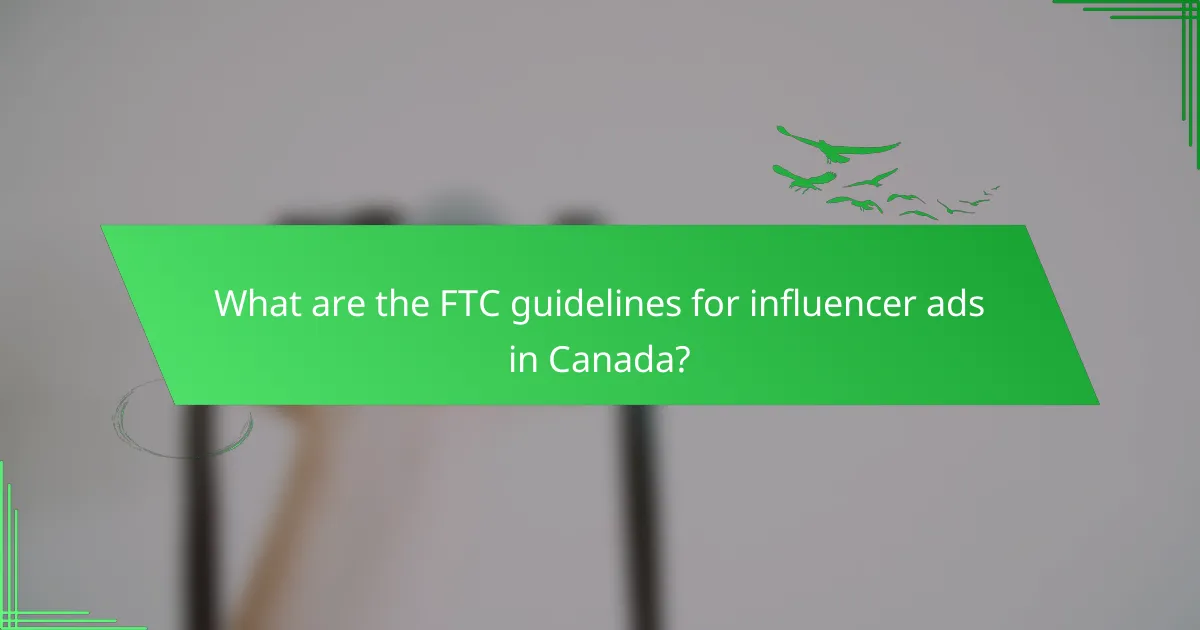The FTC guidelines for influencer ads emphasize the importance of transparency in advertising practices. Influencers and brands are required to clearly disclose any material connections, such as sponsorships or free products, to protect consumers from misleading information. Non-compliance can result in serious legal and reputational consequences, impacting both current and future business endeavors.

What are the FTC guidelines for influencer ads in Canada?
The FTC guidelines for influencer ads in Canada require clear and conspicuous disclosures when influencers promote products or services. These rules aim to ensure transparency and protect consumers from misleading advertising practices.
Disclosure requirements
Influencers must disclose their relationships with brands when promoting products. This can be done through clear statements like “ad,” “sponsored,” or “paid partnership” placed prominently in the post. The disclosure should be easy to notice and understand, ideally placed at the beginning of the content.
Using hashtags such as #ad or #sponsored is acceptable, but they should not be buried in a long list of hashtags. The key is to ensure that the audience recognizes the promotional nature of the content without ambiguity.
Content restrictions
Content shared by influencers must not make false claims about a product or service. For example, if an influencer promotes a health supplement, they cannot suggest it cures diseases unless such claims are substantiated by credible evidence. Misleading information can lead to legal consequences.
Additionally, influencers should avoid using language that could be interpreted as deceptive or exaggerated. Claims should be based on personal experience or factual information, ensuring that the audience receives accurate and honest messaging.
Enforcement mechanisms
The FTC monitors influencer advertising practices and can take action against those who fail to comply with the guidelines. This may include fines or other penalties for brands and influencers who mislead consumers. Regular audits and consumer complaints often trigger investigations.
Influencers should stay informed about the guidelines and regularly review their content to ensure compliance. Establishing a clear understanding of these regulations can help avoid potential legal issues and maintain trust with the audience.

How to ensure compliance with FTC guidelines?
To ensure compliance with FTC guidelines, influencers and brands must clearly disclose any material connections in their advertisements. This includes relationships such as sponsorships, paid promotions, or free products, which should be communicated transparently to the audience.
Best practices for disclosures
Disclosures should be clear, conspicuous, and placed in a way that is easily noticeable by the audience. Use simple language like “ad,” “sponsored,” or “paid partnership” at the beginning of posts or videos. Avoid vague terms that could confuse viewers.
Consider using hashtags such as #ad or #sponsored in social media posts. Ensure that the disclosure is not buried in a long caption or hidden behind a “more” button. The goal is to make it obvious that the content is an advertisement.
Monitoring and reporting
Regularly monitor your content to ensure ongoing compliance with FTC guidelines. This includes reviewing posts for proper disclosures and assessing audience feedback regarding transparency. Tools like analytics can help track engagement and identify any potential issues.
Establish a reporting system for any violations or unclear disclosures. Encourage followers to report suspicious content that lacks proper disclosure. This proactive approach helps maintain credibility and trust with your audience while adhering to regulatory standards.

What are the consequences of non-compliance?
Non-compliance with FTC guidelines can lead to significant repercussions for influencers and brands alike. These consequences include legal penalties and reputational damage, which can affect future business opportunities and audience trust.
Legal penalties
Legal penalties for failing to comply with FTC guidelines can range from fines to more severe sanctions. The FTC can impose monetary penalties that may reach tens of thousands of dollars per violation, depending on the severity and frequency of the non-compliance.
In some cases, the FTC may also require corrective actions, such as issuing disclosures or removing misleading content. Brands and influencers should regularly review their advertising practices to ensure they align with current regulations to avoid these legal pitfalls.
Reputational damage
Reputational damage is a significant risk associated with non-compliance. When influencers or brands fail to disclose paid partnerships, they can lose the trust of their audience, which can lead to decreased engagement and sales.
Negative publicity can spread quickly, especially on social media, where consumers are increasingly aware of advertising practices. To mitigate reputational risks, influencers should always disclose their relationships with brands clearly and consistently, maintaining transparency with their followers.

What tools can help manage influencer campaigns?
To effectively manage influencer campaigns, brands can utilize various tools designed for tracking, compliance, and performance analysis. These tools streamline processes, ensuring that campaigns align with FTC guidelines while maximizing engagement and ROI.
Influencer marketing platforms
Influencer marketing platforms serve as centralized hubs for brands to discover, connect, and collaborate with influencers. These platforms often provide features such as campaign management, performance analytics, and payment processing, making it easier to track the effectiveness of influencer partnerships.
When choosing an influencer marketing platform, consider factors like the size of the influencer network, user interface, and pricing structure. Popular platforms include AspireIQ, Upfluence, and Influencity, each offering unique features tailored to different marketing needs.
Compliance tracking software
Compliance tracking software helps brands ensure that their influencer campaigns adhere to FTC regulations regarding disclosures and advertising practices. These tools monitor content for proper labeling of sponsored posts and can generate reports to demonstrate compliance during audits.
Look for software that integrates seamlessly with your existing marketing tools and provides real-time alerts for non-compliance issues. Examples include tools like Hootsuite and Sprout Social, which offer compliance features alongside their social media management capabilities.

How to create effective influencer partnerships?
Creating effective influencer partnerships involves selecting the right influencers and establishing clear agreements that outline expectations. This ensures that both parties benefit from the collaboration and comply with relevant guidelines.
Choosing the right influencers
Selecting the right influencers is crucial for the success of your campaign. Look for influencers whose audience aligns with your target demographic, as this increases the likelihood of engagement and conversion. Consider factors such as follower count, engagement rates, and the influencer’s niche.
Evaluate potential influencers by reviewing their past collaborations and the authenticity of their content. Influencers with a genuine connection to their audience tend to drive better results. Tools like social media analytics can help assess their performance metrics.
Establishing clear agreements
Clear agreements are essential to define the roles and responsibilities of each party in the partnership. Outline deliverables, timelines, and compensation to avoid misunderstandings. This can include specifics like the number of posts, types of content, and platforms to be used.
Incorporate compliance with FTC guidelines into your agreements. Influencers should disclose their partnerships clearly, using hashtags like #ad or #sponsored. This transparency builds trust with the audience and ensures adherence to advertising regulations.

What are common misconceptions about influencer marketing?
Many misconceptions about influencer marketing can lead to compliance issues and ineffective campaigns. Understanding these myths is crucial for brands and influencers to navigate the regulatory landscape effectively.
Assuming all influencers are compliant
Not all influencers adhere to the Federal Trade Commission (FTC) guidelines regarding advertising disclosures. Some may lack knowledge about the requirements or choose to ignore them, which can result in legal repercussions for both the influencer and the brand they represent.
Brands should conduct thorough due diligence when partnering with influencers. This includes reviewing their past posts for compliance and ensuring they understand the importance of clear and conspicuous disclosures in their content.
Believing that all disclosures are the same
Disclosures in influencer marketing can vary significantly based on the platform and the nature of the content. For example, a simple “ad” may suffice on Instagram, while a more detailed disclosure may be necessary on YouTube.
It’s essential for influencers to tailor their disclosures to fit the context of their posts. Using phrases like “paid partnership” or “sponsored by” can clarify the relationship with the brand, but they must ensure that these disclosures are easily noticeable to the audience.

What emerging trends are shaping influencer advertising?
Influencer advertising is increasingly influenced by regulatory changes and a growing demand for authenticity. Brands and influencers must adapt to these trends to ensure compliance and maintain consumer trust.
Increased regulatory scrutiny
Regulatory bodies, such as the Federal Trade Commission (FTC) in the United States, are intensifying their oversight of influencer marketing. This scrutiny aims to ensure that endorsements are clearly disclosed and that consumers are not misled by deceptive practices.
Brands and influencers should familiarize themselves with guidelines that require clear labeling of sponsored content. For example, using hashtags like #ad or #sponsored can help meet these disclosure requirements. Failure to comply can result in penalties and damage to reputation.
Shift towards authenticity and transparency
Consumers are increasingly valuing authenticity in influencer marketing, leading to a shift towards more genuine and relatable content. Influencers who share personal stories and experiences tend to resonate better with audiences, fostering trust and engagement.
Brands should encourage influencers to create content that reflects their true opinions and experiences with products. This approach not only enhances credibility but also encourages more meaningful interactions with followers. Avoiding overly polished or scripted content can help maintain this authenticity.
